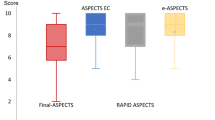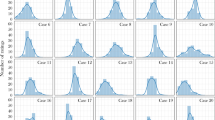Abstract
Purpose
Computer-aided diagnosis (CAD) appears promising in early ischemic change detection computed tomography (CT). This study aimed to compare the performance of two new CAD systems (Frontier ASPECTS Prototype and Brainomix) with two experienced readers in selected patients with suspected acute ischemic stroke.
Methods
Retrospectively, non-contrast brain CTs of 150 patients suspected for acute middle cerebral artery ischemia were analyzed with respect to ASPECTS first separately, than in consensus by two senior radiologists, and by use of Frontier and Brainomix. Besides the fully automatic Frontier and Brainomix readings (Frontier_1, Brainomix_1), readings adjusted for the affected brain side (known by CT angiography or clinical presentation, Frontier_2, Brainomix_2) were assessed. Statistical analysis was performed by intraclass correlation and Bland-Altman statistics.
Results
The score-based ASPECTS readings of Brainomix_1, Brainomix_2, both radiologists, and the expert consensus reading correlated highly (r = 0.714 to 0.841; always p < 0.001), whereas Frontier_1 and Frontier_2 correlated only lowly or moderately with both radiologists, the expert consensus reading, and Brainomix (r = 0.471 to 0.680; always p < 0.001). Bland-Altman analysis revealed lower mean ASPECT difference and standard deviation of difference for Brainomix_2 (mean difference = −0.2; SD = 1.15) compared to Frontier_2 (mean difference = 1.2; SD = 1.76). Correlation of region-based ASPECTS reading with the expert consensus reading was moderate for Brainomix_2 (r = 0.534), but only low for Frontier_2 (r = 0283; always p < 0.001).
Conclusion
We found high agreement in ASPECTS rating between both radiologists, expert consensus reading, and Brainomix, but only low to moderate agreement to Frontier.



Similar content being viewed by others
References
Forsting M (2017) Machine learning will change medicine. J Nucl Med 58:357–358
Obermeyer Z, Emanuel EJ (2016) Predicting the future - big data, machine learning, and clinical medicine. N Engl J Med 375:1216–1219
Erickson BJ, Korfiatis P, Akkus Z, Kline TL (2017) Machine learning for medical imaging. Radiographics 37:505–515
Lee EJ, Kim YH, Kim N, Kang DW (2017) Deep into the brain: artificial intelligence in stroke imaging. J Stroke 19:277–285
Barber PA, Demchuk AM, Zhang J, Buchan AM (2000) Validity and reliability of a quantitative computed tomography score in predicting outcome of hyperacute stroke before thrombolytic therapy. ASPECTS Study Group Alberta Stroke Programme Early CT Score. Lancet 355:1670–1674
Pexman JH, Barber PA, Hill MD et al (2001) Use of the Alberta Stroke Program Early CT Score (ASPECTS) for assessing CT scans in patients with acute stroke. AJNR Am J Neuroradiol 22:1534–1542
Bossuyt PM, Reitsma JB, Bruns DE et al (2015) STARD 2015: an updated list of essential items for reporting diagnostic accuracy studies. BMJ 351:h5527
von Kummer R, Meyding-Lamade U, Forsting M et al (1994) Sensitivity and prognostic value of early CT in occlusion of the middle cerebral artery trunk. AJNR Am J Neuroradiol 15:9–15 discussion 16-18
Patel SC, Levine SR, Tilley BC et al (2001) Lack of clinical significance of early ischemic changes on computed tomography in acute stroke. JAMA 286:2830–2838
Frontier server user manuals ASPECT Score Prototype V1_2_0. Siemens Healthcare GmbH, Erlangen
Herweh C, Ringleb PA, Rauch G, Gerry S, Behrens L, Möhlenbruch M, Gottorf R, Richter D, Schieber S, Nagel S (2016) Performance of e-ASPECTS software in comparison to that of stroke physicians on assessing CT scans of acute ischemic stroke patients. Int J Stroke 11:438–445
Nagel S, Sinha D, Day D, Reith W, Chapot R, Papanagiotou P, Warburton EA, Guyler P, Tysoe S, Fassbender K, Walter S, Essig M, Heidenrich J, Konstas AA, Harrison M, Papadakis M, Greveson E, Joly O, Gerry S, Maguire H, Roffe C, Hampton-Till J, Buchan AM, Grunwald IQ (2017) e-ASPECTS software is non-inferior to neuroradiologists in applying the ASPECT score to computed tomography scans of acute ischemic stroke patients. Int J Stroke 12:615–622
Pfaff J, Herweh C, Schieber S, Schönenberger S, Bösel J, Ringleb PA, Möhlenbruch M, Bendszus M, Nagel S (2017) e-ASPECTS correlates with and is predictive of outcome after mechanical thrombectomy. AJNR Am J Neuroradiol 38:1594–1599
Mokin M, Primiani CT, Siddiqui AH, Turk AS (2017) ASPECTS (Alberta Stroke Program Early CT Score) measurement using Hounsfield unit values when selecting patients for stroke thrombectomy. Stroke 48:1574–1579
Stoel BC, Marquering HA, Staring M et al (2015) Automated brain computed tomographic densitometry of early ischemic changes in acute stroke. J Med Imaging (Bellingham) 2:014004
Author information
Authors and Affiliations
Corresponding author
Ethics declarations
Funding
No funding was received for this study.
Conflict of Interest
The authors declare that they have no conflict of interest.
Ethical approval
All procedures performed in the studies involving human participants were in accordance with the ethical standards of the institutional and/or national research committee and with the 1964 Helsinki Declaration and its later amendments or comparable ethical standards. For this type of study formal consent is not required.
Informed consent
Informed consent was obtained from all individual participants included in the study.
Rights and permissions
About this article
Cite this article
Goebel, J., Stenzel, E., Guberina, N. et al. Automated ASPECT rating: comparison between the Frontier ASPECT Score software and the Brainomix software. Neuroradiology 60, 1267–1272 (2018). https://doi.org/10.1007/s00234-018-2098-x
Received:
Accepted:
Published:
Issue Date:
DOI: https://doi.org/10.1007/s00234-018-2098-x




